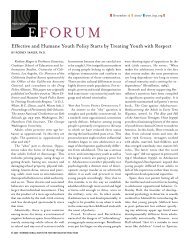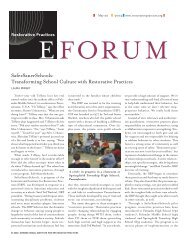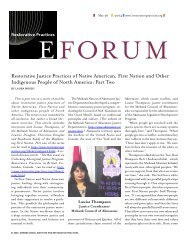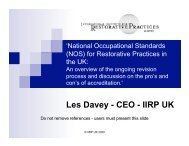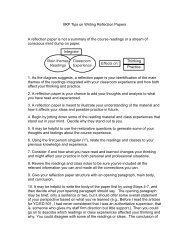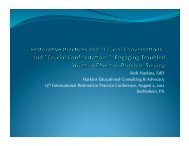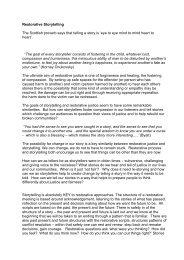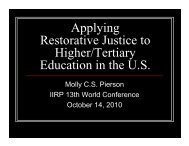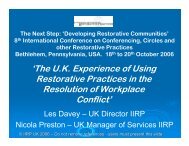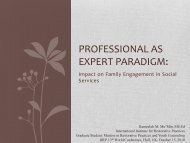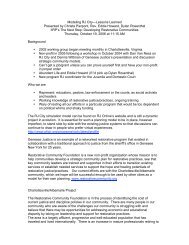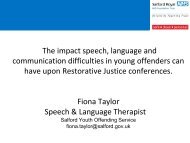Between Wholeness and Restoration - IIRP
Between Wholeness and Restoration - IIRP
Between Wholeness and Restoration - IIRP
You also want an ePaper? Increase the reach of your titles
YUMPU automatically turns print PDFs into web optimized ePapers that Google loves.
In summary, Zehr defines restorative justice in a criminal justice setting as<br />
“a process to involve, to the extent possible, those who have a stake in<br />
a specific offence <strong>and</strong> to collectively identify <strong>and</strong> address harms,<br />
needs, <strong>and</strong> obligations, in order to heal <strong>and</strong> put things as right as<br />
possible” (Amstutz <strong>and</strong> Mullet, 2005, p. 15).<br />
Ted Wachtel, an American educator who used restorative justice principles<br />
successfully in a school for delinquent youth, has been a leader in seeing its potential for<br />
educational institutions of all kinds. Initially after using formal restorative justice<br />
conferences that included the victims, offenders <strong>and</strong> their supporting community<br />
members for serious incidents of wrongdoing, he began to realize “a restorative school<br />
climate requires more than just formal restorative processes like conferencing. We will<br />
need to employ informal restorative practices as well—integrated systematically as part<br />
of everyday school life” (Wachtel (1999, p. 2). This expansion which included a<br />
continuum of practices to promote a supportive, yet limit-setting environment was<br />
dubbed restorative practices. The foundational principles, like those of restorative<br />
justice, aim to repair the harm done to people <strong>and</strong> relationships. However, Wachtel, in<br />
pulling the emphasis away from an environment of criminal justice has identified the<br />
underlying hypothesis of restorative practice to be “that human beings are happier, more<br />
cooperative <strong>and</strong> productive, <strong>and</strong> more likely to make positive changes in behaviour when<br />
those in positions of authority do things with them, rather than to them or for them” (p. 1,<br />
What is …). The continuum of practices where teachers engage with students who have<br />
harmed <strong>and</strong> are harmed includes several fundamental elements:<br />
• Foster awareness: affective statements or questions by the teacher<br />
addressed to the offending students draw attention to how their behaviour<br />
has impacted others around them. Empathy is then possible.



